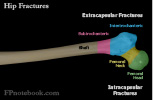II. Epidemiology
- Incidence as high as 19 per 100,000 in U.S. (250,000 cases per year)
- Uncommon in children (2% of all Pediatric Fractures)
III. Pathophysiology
- Images
- High energy injury (often in young adults)
- Motor Vehicle Accident
- Pedestrian accident
- Fall from height
- Toddlers and preschool children
- Falls
- Nonaccidental Trauma
- Atypical Femur Fractures
- May be associated with prolonged use of Bisphosphonates or Denosumab
- Stop these medications if atypical Femur Fracture occurs
IV. Diagnosis
- See Hip Fracture
- Distal to first 5 cm of femoral shaft
- Below Subtrochanteric Fracture
- Descriptive Classification
- Proximal or distal location
- Transverse or oblique angle
- Comminuted (common)
V. Pitfalls: Associated injuries (common)
- Hip Fracture including Femoral Neck Fracture
- Supracondylar Femur Fracture
- Patella Fracture
- Knee ligament injury
- Vascular Injury
- Evaluate for pulseless limb or Hemorrhagic Shock
- Consider CT angiogram of leg
VI. Imaging
- See Femur Fracture
-
XRay
- Obtain AP and Lateral Femur
- Consider Pelvic XRay
- Consider Knee XRay
- Consider Lumbar Spine XRay
- Advanced Imaging (CT, MRI)
- See Femur Fracture
VII. Management
- See Trauma Evaluation
- See Femur Fracture (includes Hare Traction Splint)
- Immobilize hip and knee
- Evaluate for associated injuries (see pitfalls above)
- Strongly consider regional Nerve Block (Fascia Iliaca Block or PENG Block) in hip and Femur Fractures
- Closely manage fluid status
- Initial Resuscitation with isotonic crystalloid
- Average blood loss from Femur Fracture: 1.2 units
- Type and Cross for 2 Units pRBC
- Continually reassess hemodynamic status
-
Fracture Management (per orthopedic Consultation)
- Age <2 years
- Closed reduction and Casting (6-8 weeks)
- Indicated if no significant angulation, rotation, comminution (otherwise surgical management)
- Diaphysis Fracture Splinting in hip spica (hips and knees both at 90 degrees)
- Closed reduction and Casting (6-8 weeks)
- Age 2 to 16 years
- Age >16 years and adults
- Open reduction and internal fixation (typically intramedullary rods)
- Age <2 years
VIII. Complications
- Significant blood loss and hemodynamic instability
- Peroneal artery and peroneal nerve injury
- Associated with distal Femur Fracture
IX. References
- Gurr in Marx (2002) Rosen's Emergency Med, p. 655-60
- Warren (2021) Crit Dec Emerg Med 35(6):16-7
- Russell (2002) Orthop Clin North Am 33(1):127-42 [PubMed]

